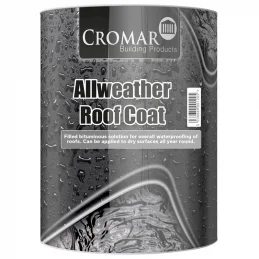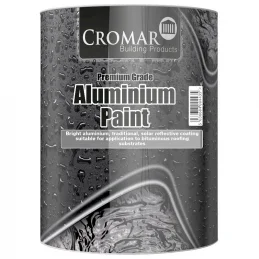Cromar Allweather Roofing, an effective, general purpose roof coating that is resistant to water almost immediately after application, therefore ideally suited for winter use.
Allweather Roofing Compound may be used to reseal, waterproof and repair many different types of roof coverings, including:-
- Asphalt roofs
- Built-up felt roofs
- Concrete roof decks
- Asbestos-cement sheeting
- Metal sheeting including iron, steel, zinc and lead
- Slates and tiles
Allweather Roofing Compound may be used in conjunction with a rot-proof hessian reinforcement scrim or a bituminised glass fibre scrim. It may also be used as a vapour barrier. Allweather Roofing Compound is not suitable for use in silage pits.
Solvent based, cold applied bituminous compound containing a small amount of organic fibre to add strength and stability.
Quick Links - Click To Jump To Section:
Features & Benefits
- Effective, general purpose roof coating
- Solvent based
- Cold applied
- Bituminous compound
- Contains a small amount of organic fibre to add strength and stability
- Resistant to water almost immediately after application
- Ideally suited for winter use
- May be used to reseal, waterproof and repair many different types of roof coverings
- May be used in conjunction with a rot-proof hessian reinforcement scrim or a bituminised glass fibre scrim
- May also be used as a vapour barrier
- Not suitable for use in silage pits
Instructions
Stir Well Before Use
No roof coating product can be expected to repair an existing roof which is not structurally sound and stable. Before using a surface coating the roof structure should be inspected and, if necessary, put in order. All cracked, broken, slipped or missing slate, tiles, sheets or other forms of covering should be replaced or re- fixed and cracks in felt or asphalt filled.
Care needs to be taken over preparation of surfaces before application and will influence the degree of adhesion and life of the renovation. All surfaces must be free from oil, dirt, dust and loose debris. All traces of algae and fungus growth should be removed using a stiff brush and the surface treated with a fungicide to kill any remaining spores thereby discouraging the return of any growths.
Asphalt Roofs
On asphalt roofs where blisters have occurred, these should be heated with a blow lamp until soft and then smoothed out. If the asphalt is crumbling or badly cracked, it must be removed and replaced with a polyester based underlay.
Allweather Roofing Compound should be applied by brush in two coats, the first being allowed to dry before the second is applied.
Built-up Felt Roofs
Remove any loose chippings and carry out the preparatory work detailed above. Minor marks and defects will be effectively filled and covered by Allweather Roofing Compound but where these are wider than 0.75mm they should be filled with Trowel Mastic and allowed to dry.
Blisters in roofing felt should be opened out, cleaned with a stiff bristled brush and coated with Allweather Roofing Compound at 1.5m² per litre. The Allweather should be allowed to set until tacky and then the felt should be re-fixed by bonding it down.
In each of the above cases the Allweather Roofing Compound and a glass membrane should then be applied.
Reinforced Concrete
Carry out preparatory work. If the deck is new it should be first allowed to cure and then priming using Universal Primer at 6-8m² per litre (rate depending upon porosity).
Lightweight Concrete
Carry out preparatory work. Allow the concrete roof deck and topping screed to cure. A glass fibre felt underlay should be partially bonded to the surface using Roofing Felt Adhesive and Cold Gritting Adhesive. The felt should be lapped, sealed and adequate ventilation provided for the materials beneath it. Allweather Roofing Compound and a glass membrane should then be applied.
Asbestos-Cement Sheeting
Carry out preparatory work. It is particularly important that the asbestos cement is not saturated with water before protective coating commences. Wait until the asbestos cement sheeting is dry and then apply one coat of Bitumen Primer. Allow the primer to dry and apply two coats of Allweather Roofing Compound. Ensure that complete contact is achieved and no air is trapped beneath the Allweather Roofing Compound.
Metal Surfaces
Where these show sign of corrosion such as loose rust this should be removed by using a wire bristled brush. A rust inhibitive treatment should be applied to ensure that the rust will not return. For normal circumstances, scrubbing with a wire brush is sufficient preparation. Allweather Roofing Compound should then be applied in two coats at the rate of 1.5m² per litre per coat.
Slate and Tiles
Carry out preparatory work. The roof should be examined for damaged or loose slates or tiles. Any loose tiles or slates should be re-fixed firmly in place. Allweather Roofing Compound and a glass membrane should then be applied.
Scrim Treatment
In order to bridge gaps, cracks and fissures and in all cases where roof surfaces are in advances states of decay, it is recommended that Allweather Roofing Compound be used in conjunction with a reinforcing membrane, either rot-proof Hessian or, preferably glass membrane.
Having ensured that the surface is clean and receptive to the coating product, apply a first coat at 1m² per litre. Immediately apply the glass membrane into the wet Allweather Roofing Compound film using a brush charged with Allweather. Ensure that complete contact is achieved and that no air is trapped beneath the Allweather Roofing Compound.
The glass membrane should be lapped by 50 to 75mm and the inside of each lap should be painted with the Allweather Roofing Compound. Small gaps and differences in levels should be bridged ensuring that the glass membrane is not pulled too tightly across the gap so that any movements in the structure will be accommodated. Least 150mm and secure using self adhesive flashing (150mm width) allowing 75mm to be in contact with the brickwork above. Apply a second coat of Allweather Roofing Compound and allow this to dry.
Final Surface
It is beneficial to the coating and to the rest of the roof structure to give a final solar reflective finish. An exposed black bituminous surface should be avoided on a pitched or flat roof. When using Allweather Roofing Compound a third and final coat should be preferably applied at 1.5m² per litre and, while the film is still tacky well blinded with 1 to 2mm (7 to 14 mesh) stone chippings or clean sharp sand. Alternatively onto the final Allweather coating which should be allowed to weather for a minimum of two weeks, preferably one month, a solar reflective coating can be provided using Aluminium Paint.
Vapour Barrier
When insulating material is placed on a flat roof deck it is essential to prevent condensation water vapour from entering the insulation. If this is allowed to happen it can damage the insulation. Two coats of Allweather Roofing Compound, the first applied at 1m² per litre, will help prevent this. The Allweather Roofing Compound should be applied to the ‘warm’ side, care being taken to avoid pinholes and imperfections in the coating. After the Allweather Roofing Compound has dried the insulation may be applied over it.
VOC Details
EU Limit for this product CAT. 2(i) : 500g/l (2010). This product contains max. 270g/l VOC’s
Coverage
Allweather Roofing Compound should normally be applied in two coats at 1-1.5m² per litre depending upon the porosity of the surface.
Cleaning Tools
Tools may be cleaned with White Spirit. Minor spillages should be wiped off surfaces before the Allweather Roofing Compound has set. Major spillages should be mopped up immediately with an inert, absorbent material, such as sand and disposed of in accordance with regulations.
Storage Life
Minimum 12 months in undamaged, tightly sealed containers. Allweather Roofing Compound should be stored indoors away from all sources of ignition, naked flames and hot lights etc.




